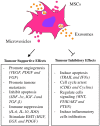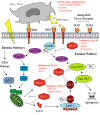Mesenchymal Stem Cell Expressing TRAIL as Targeted Therapy against Sensitised Tumour
- PMID: 30060445
- PMCID: PMC6121609
- DOI: 10.3390/ijms19082188
Mesenchymal Stem Cell Expressing TRAIL as Targeted Therapy against Sensitised Tumour
Abstract
Tapping into the ability of engineered mesenchymal stem cells (MSCs) to mobilise into the tumour has expanded the scope of cancer treatment. Engineered MSCs expressing tumour necrosis factor (TNF)-related apoptosis inducing ligand (MSC-TRAIL) could serve as a platform for an efficient and targeted form of therapy. However, the presence of cancer stem cells (CSCs) that are resistant to TRAIL and apoptosis may represent a challenge for effective treatment. Nonetheless, with the discovery of small molecular inhibitors that could target CSCs and tumour signalling pathways, a higher efficacy of MSC-TRAIL mediated tumour inhibition can be achieved. This might pave the way for a more effective form of combined therapy, which leads to a better treatment outcome. In this review, we first discuss the tumour-homing capacity of MSCs, its effect in tumour tropism, the different approach behind genetically-engineered MSCs, and the efficacy and safety of each agent delivered by these MSCs. Then, we focus on how sensitisation of CSCs and tumours using small molecular inhibitors can increase the effect of these cells to either TRAIL or MSC-TRAIL mediated inhibition. In the conclusion, we address a few questions and safety concerns regarding the utilization of engineered MSCs for future treatment in patients.
Keywords: TRAIL; apoptosis; cancer stem cells; mesenchymal stem cells; sensitisation; tumours.
Conflict of interest statement
The authors declare no conflict of interest.
Figures


Similar articles
-
Dual-targeted antitumor effects against brainstem glioma by intravenous delivery of tumor necrosis factor-related, apoptosis-inducing, ligand-engineered human mesenchymal stem cells.Neurosurgery. 2009 Sep;65(3):610-24; discussion 624. doi: 10.1227/01.NEU.0000350227.61132.A7. Neurosurgery. 2009. PMID: 19687708
-
Mesenchymal stromal cell delivery of full-length tumor necrosis factor-related apoptosis-inducing ligand is superior to soluble type for cancer therapy.Cytotherapy. 2015 Jul;17(7):885-96. doi: 10.1016/j.jcyt.2015.03.603. Epub 2015 Apr 14. Cytotherapy. 2015. PMID: 25888191 Free PMC article.
-
pIL6-TRAIL-engineered umbilical cord mesenchymal/stromal stem cells are highly cytotoxic for myeloma cells both in vitro and in vivo.Stem Cell Res Ther. 2017 Sep 29;8(1):206. doi: 10.1186/s13287-017-0655-6. Stem Cell Res Ther. 2017. PMID: 28962646 Free PMC article.
-
TRAIL based therapy: overview of mesenchymal stem cell based delivery and miRNA controlled expression of TRAIL.Asian Pac J Cancer Prev. 2014;15(16):6495-7. doi: 10.7314/apjcp.2014.15.16.6495. Asian Pac J Cancer Prev. 2014. PMID: 25169476 Review.
-
Cytotherapies in multiple myeloma: a complementary approach to current treatments?Expert Opin Biol Ther. 2013 Jun;13 Suppl 1:S23-34. doi: 10.1517/14712598.2013.796357. Epub 2013 May 24. Expert Opin Biol Ther. 2013. PMID: 23701130 Review.
Cited by
-
Anti-cancer immune responses to DNA damage response inhibitors: Molecular mechanisms and progress toward clinical translation.Front Oncol. 2022 Oct 6;12:998388. doi: 10.3389/fonc.2022.998388. eCollection 2022. Front Oncol. 2022. PMID: 36276148 Free PMC article. Review.
-
Site-Specific Integration of TRAIL in iPSC-Derived Mesenchymal Stem Cells for Targeted Cancer Therapy.Stem Cells Transl Med. 2022 Mar 31;11(3):297-309. doi: 10.1093/stcltm/szab031. Stem Cells Transl Med. 2022. PMID: 35267023 Free PMC article.
-
Behind the Adaptive and Resistance Mechanisms of Cancer Stem Cells to TRAIL.Pharmaceutics. 2021 Jul 10;13(7):1062. doi: 10.3390/pharmaceutics13071062. Pharmaceutics. 2021. PMID: 34371753 Free PMC article. Review.
-
Targeting of CD133+ Cancer Stem Cells by Mesenchymal Stem Cell Expressing TRAIL Reveals a Prospective Role of Apoptotic Gene Regulation in Non-Small Cell Lung Cancer.Cancers (Basel). 2019 Aug 28;11(9):1261. doi: 10.3390/cancers11091261. Cancers (Basel). 2019. PMID: 31466290 Free PMC article.
-
Cell-Based Nanoparticles Delivery Systems for Targeted Cancer Therapy: Lessons from Anti-Angiogenesis Treatments.Molecules. 2020 Feb 7;25(3):715. doi: 10.3390/molecules25030715. Molecules. 2020. PMID: 32046010 Free PMC article. Review.
References
-
- Bray F., Ferlay J., Laversanne M., Brewster D.H., Gombe Mbalawa C., Kohler B., Pineros M., Steliarova-Foucher E., Swaminathan R., Antoni S., et al. Cancer incidence in five continents: Inclusion criteria, highlights from Volume X and the global status of cancer registration. Int. J. Cancer. 2015;137:2060–2071. doi: 10.1002/ijc.29670. - DOI - PubMed
Publication types
MeSH terms
Substances
LinkOut - more resources
Full Text Sources
Other Literature Sources

